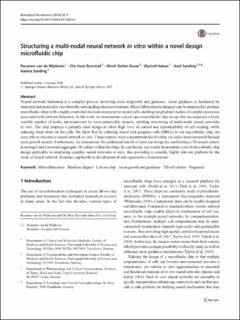Structuring a multi-nodal neural network in vitro within a novel design microfluidic chip
van de Wijdeven, Rosanne; Huse Ramstad, Ola; Bauer, Ulrich Stefan; Halaas, Øyvind; Sandvig, Axel; Sandvig, Ioanna
Journal article, Peer reviewed
Accepted version
Permanent lenke
https://hdl.handle.net/11250/2988035Utgivelsesdato
2018Metadata
Vis full innførselSamlinger
Sammendrag
Neural network formation is a complex process involving axon outgrowth and guidance. Axon guidance is facilitated by structural and molecular cues from the surrounding microenvironment. Micro-fabrication techniques can be employed to produce microfluidic chips with a highly controlled microenvironment for neural cells enabling longitudinal studies of complex processes associated with network formation. In this work, we demonstrate a novel open microfluidic chip design that encompasses a freely variable number of nodes interconnected by axon-permissible tunnels, enabling structuring of multi-nodal neural networks in vitro. The chip employs a partially open design to allow high level of control and reproducibility of cell seeding, while reducing shear stress on the cells. We show that by culturing dorsal root ganglion cells (DRGs) in our microfluidic chip, we were able to structure a neural network in vitro. These neurons were compartmentalized within six nodes interconnected through axon growth tunnels. Furthermore, we demonstrate the additional benefit of open top design by establishing a 3D neural culture in matrigel and a neuronal aggregate 3D culture within the chips. In conclusion, our results demonstrate a novel microfluidic chip design applicable to structuring complex neural networks in vitro, thus providing a versatile, highly relevant platform for the study of neural network dynamics applicable to developmental and regenerative neuroscience.
